The New Service Economy - KK-stiftelsen
The New Service Economy - KK-stiftelsen
The New Service Economy - KK-stiftelsen
Create successful ePaper yourself
Turn your PDF publications into a flip-book with our unique Google optimized e-Paper software.
<strong>The</strong> <strong>New</strong> <strong>Service</strong> <strong>Economy</strong><br />
search outlets has been sacrificed at the expense of quantity of publications.<br />
Although there are a few articles that have appeared in high quality journals,<br />
an overwhelming majority of the journal publications are in what many service<br />
scholars would consider mid-level outlets. A recommendation made at<br />
the mid-point review of the profile (in May 2005) was that the focus in future<br />
dissemination of research should be on getting papers published in<br />
higher quality journals (such as the Journal of Marketing); however, the<br />
evidence presented in the self report did not suggest this strategy has been<br />
successfully pursued. (Perhaps there are several projects in process that may<br />
indeed end up in such publication outlets. As noted in the self-evaluation<br />
report, the publication cycle tends to be longer in the higher quality journals.<br />
However, the report merely indicates that two papers “aiming for top ranked<br />
journals are in the review process.”)<br />
Perhaps one reason for the relatively large number of mid-level publications<br />
is that many of the research projects have been driven by students<br />
(mini-researchers). Of course, several projects have been done by Ph.D.<br />
students. However, even using Ph.D. students for such research can be a<br />
double-edged sword. On one side, having a relatively large number of very<br />
motivated students doing the research has led to many papers. (As we understand<br />
it, the Ph.D. dissertation process in Sweden requires 4-6 research<br />
papers that are published.) However, on the other side, research that is<br />
driven by relatively inexperienced researchers (i.e., Ph.D. students, masters<br />
students, bachelors students) is likely to have a much more difficult time<br />
navigating the publication process in the top-tier journals (e.g., Journal of<br />
Marketing, Journal of <strong>Service</strong> Research, Journal of the Academy of Marketing<br />
Science). Thus, the “quantity vs. quality” issue in term of publications<br />
may be due in large part to high use of Ph.D. students to do much of the<br />
profile research.<br />
On a related note, we believe a metric that merely identifies the number<br />
of publications is not a sufficient measure of quality of the research being<br />
produced from the profile. Metrics are also needed to determine the quality<br />
of the publications. One means to do this might be for a ranking of the quality<br />
of the journals where the publications are occurring. Although there are<br />
certainly problems with this approach (e.g., poor articles get published in<br />
“good” journals and good articles get published in “poor” journals), merely<br />
tallying the quantity of publications does not provide a complete picture of<br />
the overall quality of and contributions made by the research.<br />
CTF appears to be using good methods to identify the relevance and improve<br />
the quality of the research. From the Knowledge Foundation funded<br />
research projects, CTF gave nearly 100 conference presentations. By attending<br />
so many conferences CTF has done an excellent job of networking in<br />
the international community of service research scholars. <strong>The</strong> presentations<br />
made at these conferences also provide a good means to get feedback on<br />
research, particularly in its early stages. Most of the conferences have re-<br />
61


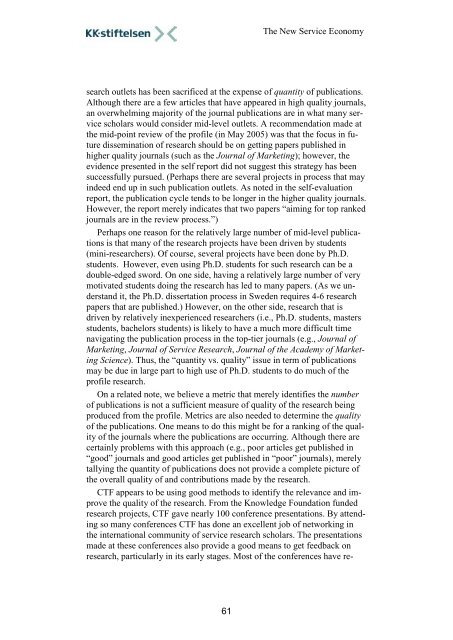
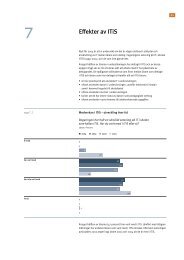
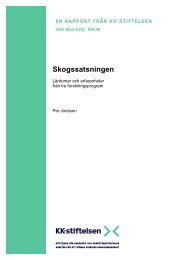
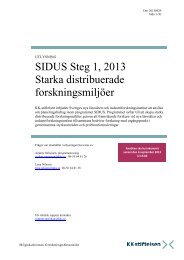
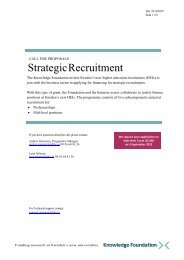
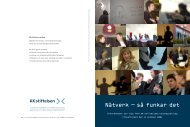
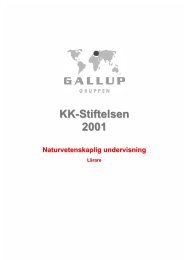



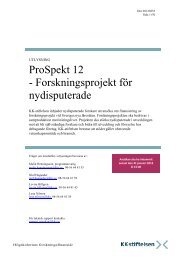
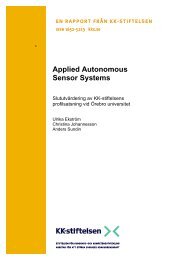

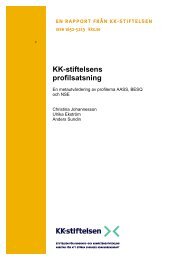
![[Klicka här och skriv titel] - KK-stiftelsen](https://img.yumpu.com/23861299/1/184x260/klicka-har-och-skriv-titel-kk-stiftelsen.jpg?quality=85)